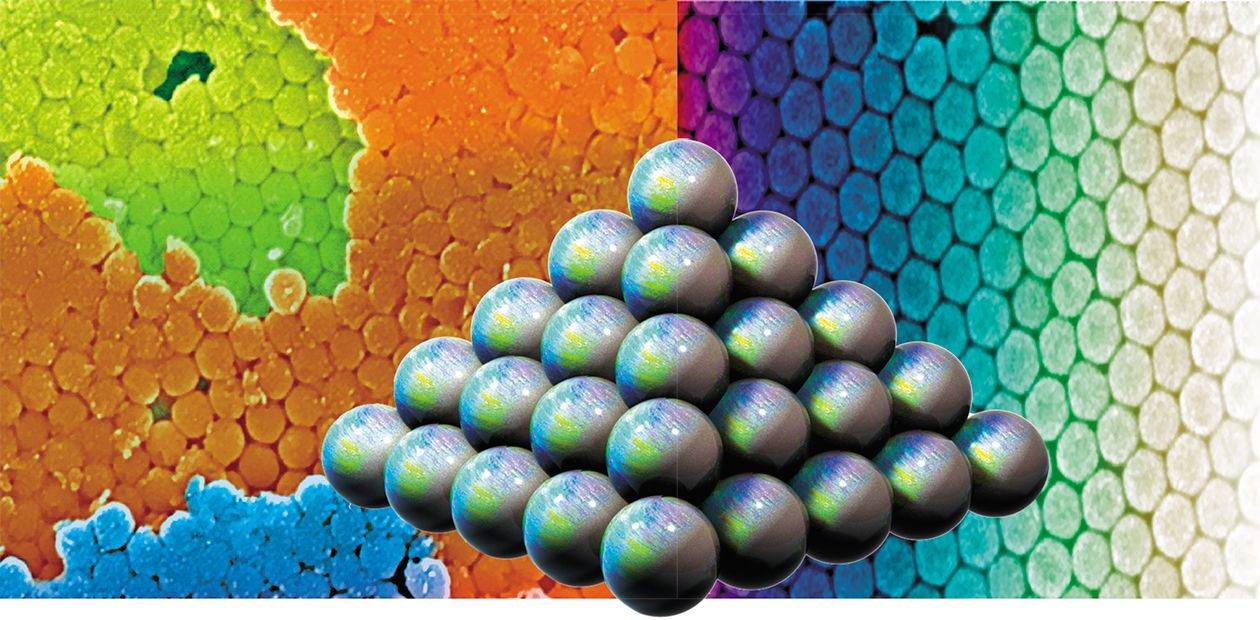From Precious OPAL to Nanofilms
Synthetic gems can surprise no one today. Man-made rubies and sapphires shine in rings and earrings, while synthetic diamonds, as the hardest natural stones, are applied in industries other than jewelry industry. Few people know, however, that the major difficulties were encountered in synthesis of precious opal, one of the most unusual and mysterious minerals with diamond-type color interplay. After studying the dynamics of opal growth in detail, researchers learned to produce an artificial mineral similar to the natural one. Unusual characteristics of this precious stone attract not only lovers of luxury but also physicists and technologists, because this mineral may be helpful in creating photonics of the future…
This wonderful stone has a speaking name. It is assumed to originate from the Sanskrit word “upala,” which means “a precious stone.” Precious opal does stand to its name: it is in the league with colored precious stones, such as emeralds and rubies, and the cost of black precious opal is even higher than that of brilliants.
A unique feature of this stone is the enchanting color interplay caused by white light diffraction into colored components. This phenomenon occurs because of the regular nano-sized internal structure of the stone, which is similar to the crystalline structure.
Any sample of precious opal consists of contacting domains (blocks) with a regular structure, which are aligned differently. That is why the “pattern” of the diffraction interplay initiated by turning the stone with respect to incident light is so variable and rich in colors; that is why an amazing effect of the “live” color rainbow of this unusual mineral is created.
Most deposits of precious opal (96 %) are located on one continent — Australia. The first attempts to synthesize artificial opals were made by the Frenchman Pierre Gilson in 1974. Today two Japanese companies — Kyocera and Inamori — produce commercial synthetic opals using the technology they developed. The name of these stones is Gilson opals, because they are actually simulations of natural stones: the space between the silica particles in these stones is filled with plastic.
There are no deposits of precious opal in Russia. This was one of the reasons why, about 30 years ago, researchers from the Novosibirsk Institute of Geology and Mineralogy, the technology they developed. The name of these stones is Gilson opals, because they are actually simulations of natural stones: the space between the silica particles in these stones is filled with plastic.
Sedimentation or nano-scale crystallization?
The fact that the regular structure of precious opal is composed of monodisperse silica spheres (MSS) was first reported in 1964. After that, many researchers studied the internal structure of this mineral by electron microscopy.
From the moment the regular structure of precious opal was discovered and until recently, this mineral was believed to form as a result of gravity-induced sedimentation of MSSs from alkaline colloid solutions (suspensions) in cracks and voids of sedimentary rocks with their subsequent arrangement (self-assembling) into a crystal-like structure.
This was the way (spontaneous MSS sedimentation or centrifugal sedimentation from water or ethyl alcohol suspensions) synthetic opals were produced by Novosibirsk researchers, who also supported the gravity-induced theory of opal growth at the beginning. The first guess that not everything was that simple and that this mineral was the result of a variant of the crystallization process was made after Novosibirsk researchers visited Australia in 1996, where they saw a lot of samples of the Australian precious opal.
Yet, the final conclusion that precious opal forms through volume crystallization of concentrated (owing to sedimentation) MSS suspensions was made after the publication by T. Jacubo, a Japanese researcher (Okubo, 1993) who studied thermodynamics of ordering of suspensions of polystyrene, methyl methacrylate, and silica spherical particles. Further on, Novosibirsk researchers managed rather rapidly to organize directed volume crystallization of opal in different variants: from the surface of a concentrated suspension downward and, vice versa, from the vessel bottom up to the surface; moreover, they also managed to grow individual single crystals of opal on the suspension surface.
It became obvious that suspensions were growing more concentrated owing to MSS sedimentation; and as the concentration reached a critical value, opal crystallization began. The structural blocks being formed were nothing else than nanocrystals, and the overall polycrystalline structure of opal looked similar to a highly “magnified” structure of a metal.
Retrospective view of crystals
It should be emphasized that the term “crystalline structure” with respect to natural or synthetic opals is yet conventional: these structures are crystals only from the retrospective viewpoint. Actually, participants of nanocrystallization in condensed suspensions are negatively charged spherical silica particles surrounded by a double diffusion layer of counter-ions; hence, these structures as a whole are electrically neutral.
The latter are involved in inter-particle interaction: molecular attraction of MSS masses, gravity-induced forces as an equivalent of molecular attraction, and electrostatic repulsion in the case of contact of counter-ion atmospheres. At distances between the particles typical of concentrated suspensions, repulsion forces are much stronger than attraction forces; hence, the volume where the process occurs has to be restricted for nanocrystallization to be successful (the so-called space-limited environment has to be created).
Thus, in reality, the MSSs are located in the regular structure of opal at a certain distance from each other and are divided by liquid interfaces of the dispersion medium. The thickness of these interfaces is approximately equal to the thickness of two ion atmospheres of the neighboring particles. It is to these “real” nanocrystals that all theoretical considerations and calculations, as well as experiments performed refer. Losing the dispersion medium, the nanocrystals transform to “dry” nanostructures with directly contacting MSSs. This is what we call opal.
The DLVO theory (the name originates from the first letters of the researchers’ names: Derjaguin, Landau, Verwey, and Oberbeek) makes it possible to calculate the potential energies of attraction and repulsion at real distances between particles in the suspension or in the original nanocrystal. Yet, the approach based on these postulates is little useful in analyzing the nanocrystallization process. It seems more reasonable to solve this problem from the viewpoint of forces of inter-particle interaction rather than from the viewpoint of particle energy. In addition to attraction/repulsion and gravity-induced forces, one also has to take into account the forces of dipole interaction, which arises during deformation of the ion atmosphere.
Such an approach allows one, in particular experiments, to calculate the values of the oppositely acting forces and to correct their action at the suspension stage , thus reaching an almost complete balance of forces, which is the case in nanocrystals.
Nanocrystals containing a dispersion medium can be easily destroyed mechanically and become dispersed in their own dispersion medium (water or ethyl alcohol) to a secondary suspension, which again becomes crystallized at rest. The mechanism of this phenomenon, known as reversible thixotropy, which was unclear previously, can now be readily explained within the framework of the concepts described above.
Based on the theory of nanocrystallization of precious opal, researchers were able to approach the synthesis of high-quality gems with great care, to understand the nature of multiple defects of the structure, and to develop methods for avoiding these defects. As a result, it became possible to obtain not only mineral samples identical to the natural stone in terms of all parameters, but also volume opal nanocrystals with high photonic and crystalline characteristics studied at the Ioffe Physico-Technical Institute of the Russian Academy of Sciences.
Opal nanofilms
The regular nanostructure of opal has attracted the physicists’ attention as a promising photonic crystalline material (Yablonovitch, 1987). Further research in this field was performed both in Russia (at the Ioffe Physico-Technical Institute) and in several large research centers abroad. Researchers’ attention was focused on obtaining opal films on a solid substrate. Being optically transparent, these films can consist of tens of MSSs layers and have a thickness up to several microns.
High-quality opal films are the basic material for a variety of functional materials to be used in various microphotonic devices, such as switches, re-tuned filters, waveguides, microlasers, superprisms, waveguide splitters, resonators, etc. As the general features of the behavior of photonic crystals can be compared with the behavior of semiconductor crystals, we can reasonably assume that photonics operating on the basis of “light” will gradually replace electronic devices.
There is a significant obstacle on this way, however: it turned out that both bulk crystals and films contain many structural defects. The main defects are the polycrystalline character, twinning, and microcracks. It was a difficult task to avoid the emergence of these defects and to obtain high-quality opal films with a monocrystalline structure over the entire substrate surface. And yet, the task was feasible. Based on the concepts of nanocrystallization, rather than on the “self-assembling” process, Novosibirsk researchers learned to grow monocrystalline thin-film photonic crystals with the minimum possible number of defects by the swept meniscus method. The reflection factor of these films in the photonic forbidden band reaches 90 %.
The problem of obtaining functional materials on the basis of opal films reduces, in particular, to creating regularly aligned rather than random defects in the monocrystalline film, which stimulate origination of allowed states in the photonic forbidden band. One of the basic ways of solving this problem is nanocrystallization of the so-called optical superlattices or heterostructures.
There are two possibilities of obtaining opal-based heterostructures. One is based on joint nanocrystallization of spherical particles of two different sizes, with coarse particles being distributed among fine particles in accordance with a certain law, while fine particles are also organized into a sophisticated structure. Thus, one regular structure is nested in another one. By the way, similar densely packed structures consisting of MSSs of two sizes are also observed in natural opals; the principal possibility of creating nested heterostructures under laboratory conditions has been already proved by Novosibirsk researchers.
The second possibility is related to applying an opal film consisting of particles of an identical size onto a film consisting of particles of another size. As a result, the researchers managed to obtain both binary packets demonstrating two photonic forbidden bands and packets consisting of three films. In the latter case, the forbidden bands merge into one band, but it has four allowed states.
Strictly speaking, the term “heterostructures” is correct only as applied to alternating layers of MSSs of different sizes with the thickness of each layer equal to one or two particles. The term can be used to mean films with the thickness of several particle layers rather conventionally, because here we actually have a superposition of two or three independent thin-film photonic crystals. It is impossible to obtain true heterostructures with alternating layers of particles through nanocrystallization in a swept meniscus.
Yet, Novosibirsk researchers recently managed to create principally new (lyophilic) suspensions of MSSs in dimethyl sulfoxide, which offer new possibilities. In these suspensions, there are no diffusion layers of counter-ions around MSSs, while the contact and coagulation of particles are prevented by dimethyl sulfoxide shells surrounding MSSs. Owing to this property, other colloids and substances can be inserted into such suspensions without risking particle coagulation, which opens wide possibilities of obtaining photonic crystalline materials with new functional properties.
Assembling of MSSs to such thin-film photonic crystals occurs by a mechanism different from that described above. The opal films obtained are of much better quality: the reflection factor in the forbidden band reaches 96 %; the main feature is that new suspensions allow obtaining true heterostructures with alternation of layers of particles of two sizes and also nested heterostructures.
The results of more than 30-years’ activities of Novosibirsk researchers in the “opal field” illustrate the evolution of scientific ideas bringing more and more technological “fruit” as they are consecutively developed. Starting with the development of a technology for synthesizing precious opal as a synthetic precious stone for the needs of jewelry industry, researchers based their study on the theory of nanocrystallization and solved the problem of growing monocrystalline opal films. The latter, in turn, form the basis for production of various photonic crystalline materials, which may become one of the most demanded advanced technologies in the near future
References
1. N. D. Deniskina, D. V. Kalinin, and L. K. Kazantseva. Precious Opals. Natural and Synthetic [in Russian]. — Nauka, Novosibirsk, 1987. — 183 pp.
2. V. V. Serdobintseva and D. V. Kalinin. Mechanism of reversible thixotropic transformation in concentrated suspensions of monodisperse spherical silica particles from the viewpoint of formation and growth of colloid particles // Kolloid. Zh. — 2001. — Vol. 65. — No. 5. — Pp. 686—689.
3. D. V. Kalinin, A. I. Plekhanov, V. V. Serdobintseva, and V. F. Shabanov. Photonic heterostructures based on monocrystalline opal films // Dokl. Ross. Akad. Nauk. — 2007. — Vol. 413. — No. 3. — Pp. 329—331.










